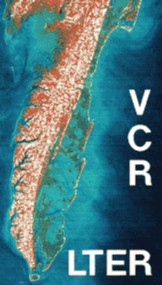 The Potential for Dissimilatory Nitrate Reduction to Ammonium in Salt Marsh Sediments |

Tobias, C. R., Anderson, I. C., and Berry, B. E.
Biological Sciences
|
 The Potential for Dissimilatory Nitrate Reduction to Ammonium in Salt Marsh Sediments |

Tobias, C. R., Anderson, I. C., and Berry, B. E.
Biological Sciences
|
Nitrate is a source of "new" nitrogen in salt marshes exposed to N-contaminated ground or surface waters. Salt marshes, either natural or constructed, are often used to remediate nitrogen-loaded surface waters. An additional source of nitrate is wet deposition. Allochthonous nitrate introduced to a salt marsh may be reduced either by denitrification to N2 (DNR) or by dissimilatory nitrate reduction to ammonium (DNRA). Depending upon which of these microbial processes is dominant, nitrogen will either be conserved in the marsh sediments as NH4+ or organic N or lost to the atmosphere as N2O and N2. We have measured DNR, DNRA, ammonium production, and nitrate disappearance in cores and slurries taken from a Spartina alterniflora salt marsh. DNRA was measured using 15NO3- (1mM ) as a tracer. DNR was measured using both acetylene blockage and 15N2O pool dilution techniques. In anaerobic slurries DNRA accounted for all of the nitrate reduced; in aerobic cores DNRA accounted for 60 - 100% of the nitrate disappearance. DNRA in deeper sediments (> 5cm) accounted for 80-100% of nitrate loss, while DNR in deeper sediments was nondetectable. This suggests that nitrate inputs contacting the marsh surface (precipitation) will be both exported via DNR and conserved via DNRA, but that nitrate contacting deeper sediments (perhaps from groundwater sources) will be conserved as ammonium through DNRA.